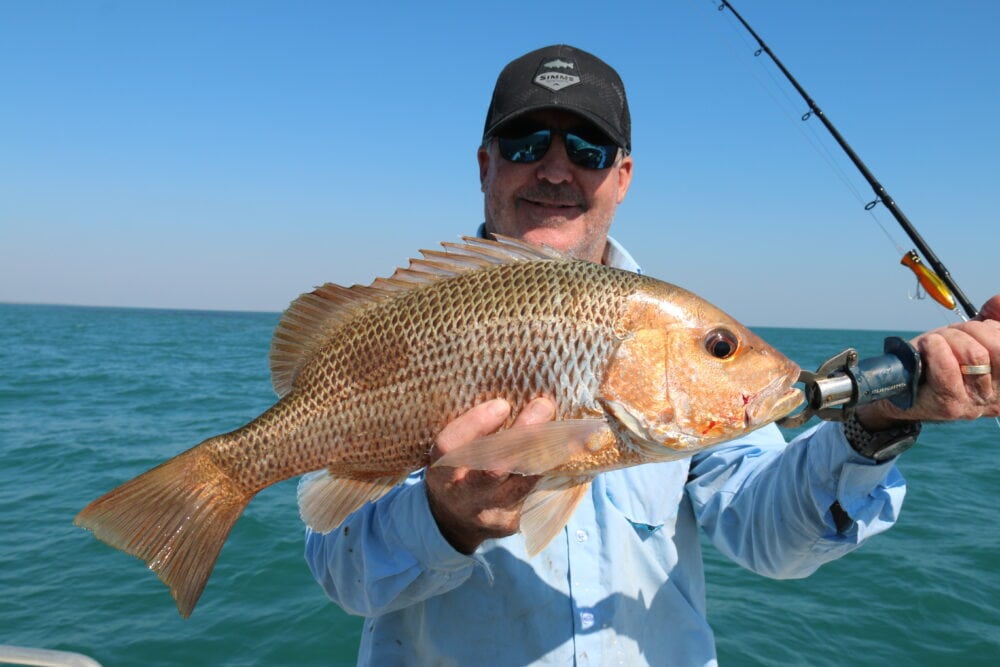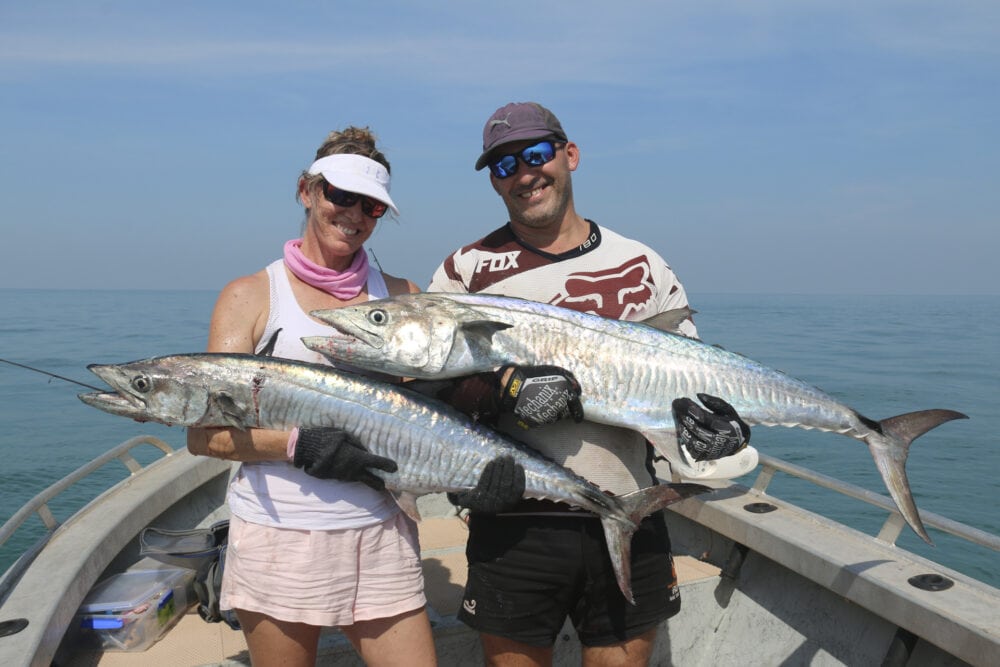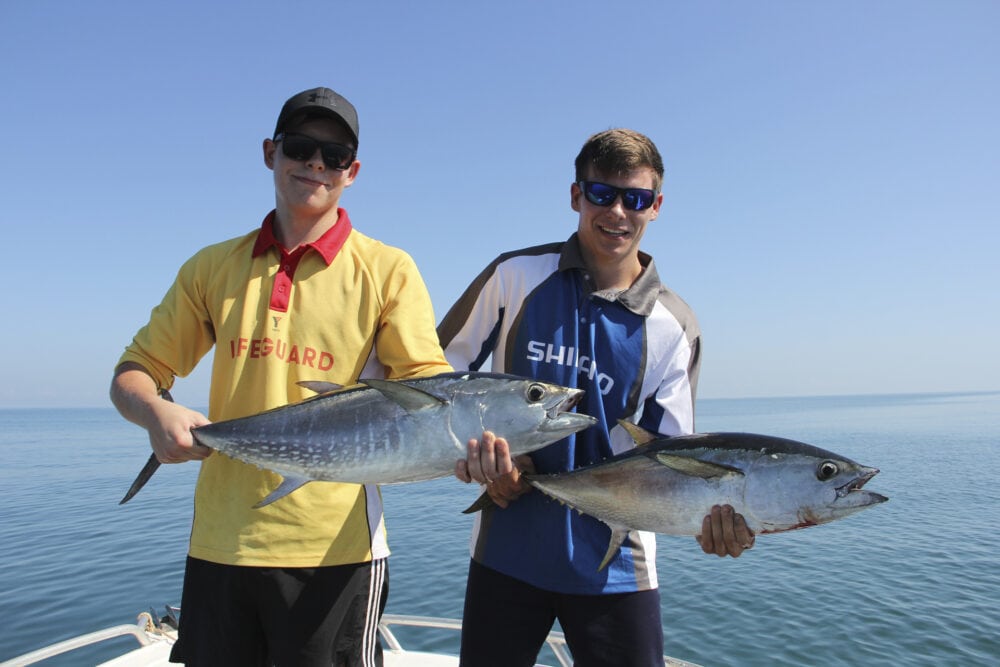Bare Sand Island – By Chris Errity
One of my favourite areas to fish is Bare Sand Island, which is situated near Bynoe Harbour and can be accessed from a number of public ramps. The closest ramp in Bynoe Harbour is Six Pack creek, off Barramundi drive and just over an hour’s drive from Darwin. You will need at least 3.5m of tide to use this ramp as it is situated well up Six Pack creek and has a large drop-off. This ramp provides a great sheltered trip to the island, only coming across a short stretch of open water as you travel past Indian Island out towards Bare Sand. It is a distance of around 15km from the ramp. It can also be readily accessed from the Dundee Beach ramp, which is around a 90-minute drive from Darwin. You can access Dundee ramp with around 3.3m of tide. This trip is a little more open as you travel along the coast heading north for about 20km.
Bare Sand Island is a popular area to visit for fishing, camping and observing flat back sea turtles that come to nest there during the dry season from May to August. It is a reasonably large island that has very little vegetation. You can swim there, but great care must be taken, as saltwater crocodiles inhabit the area. During neap tides, the water is extremely clear around the island and great fishing can be had off the beach. The most common species encountered include blue salmon, Queenfish and several species of trevally.
There is a significant channel on the southern side of the island that provides safe travel to and from the island at any stage of the tide and provides safe anchorage if you want to stay on the island overnight. This channel is also a great area to target large Queenfish that regularly school up, particularly on the outgoing tide. One of the best ways to target these impressive sportfish is to troll lures until you find the school. Once you find the school, you can cast a variety of surface lures or metal slices. Both types of lure work well and the surface strikes received from these pelagic speedsters are impressive to say the least.
Bare Sand is a great base to fish Roche and Bass reefs that are only around 10km to the west. These extensive reef systems provide the angler with plenty of opportunities to target both reef fish and pelagic species. I particularly like to target Spanish mackerel on these reefs during the Dry season when they are more common in this area. Look for large bombies on these reefs that often hold their own bait schools. Oceanic Queenfish and garfish are the most common types of baitfish and mackerel are extremely partial to them. I have often witnessed large Spaniards tearing up these baits schools in voracious feeding sessions.
Trolling large minnows works well when targeting Spanish mackerel. I prefer to use more natural colours with purple, blue and green being some of my favourites. Observe the depth of water that the mackerel are feeding in and then select the appropriate depth lure to target them. I have found that the most common depth to troll at in these areas is around 3-4m depending on the depth of the reef. Sometimes the reef will come up to only a couple of metres below the surface and this is when trolling shallow diving lures such as the Reidys big ass 200 will work extremely well. I have also had some success trolling and casting stick baits and poppers over these shallower reefs. Not only will Spanish mackerel respond well to surface lures, but also other pelagic species such as Queenfish, trevally, cobia and longtail tuna are regularly encountered.
Roche and Bass reefs seem to be more productive on the outgoing tide. I like to fish these areas for pelagics just after the neaps as the tides start to build along with the tidal movement and the water clarity is still good. The last hour before the low tide has also been incredibly productive for me as has the first of the incoming.
I have also landed many Spaniards on jigs and metal slices too. Longtail tuna can be found in this area too with large schools also becoming more prevalent through the dry season. They can be easily targeted using small metal slices around 40g, but also respond well to stick baits. I have caught many tuna on stick baits and it has to be one of the most exciting ways to target these fish.
When you observe up to 10 tuna bustling each other out of the way as they try to inhale your stick bait off the surface, you cannot help but get excited.
Schools of longtail tuna can be encountered near Roche and Bass reefs, but can also be found in closer to Bare Sand Island. I have often encountered many schools of them when heading out to the reefs from the island. Large bait schools often congregate in this area and sometimes Queenfish and grey mackerel can be found here as well. The grey or broad bar mackerel is another pelagic species that often appears in these areas. They are great fun to catch and can obtain sizes of up to 8kg, but are more commonly found around 3-5kg in size. Sometimes large schools of grey mackerel move into these areas and can be seen feeding on garfish right up on top of the reefs. When this occurs the best way to catch them is to tie on a metal slice and cast it into the school. A high retrieve reel is necessary in this case as you need to wind as fast as you possibly can to induce a strike from these pelagic speedsters.
Many reef fish species can be found in this area as well. The most highly sought after species include golden snapper, tusk fish, coral trout and mangrove jack. I have had great success on these species using several types of lures. Gulp plastics, Reidys soft vibes and metal jigs have been the most successful. I personally would use soft vibes in preference to the other lures, as they have been so successful for me. Everything seems to be attracted to vibes. There is just something about that enticing vibe movement that triggers fish to strike.
I enjoy fishing around the coral bombies on the neap tides as the water clarity improves. Much of the time, I am fishing in depths of only two metres and sight casting to fish as they swim around the edges of the bombies. Coral trout are particularly aggressive and readily smash soft vibes. I also find that placing Berkley gulp gel on the vibes improves my chances of catching fish. Golden snapper and mangrove jack are also incredibly aggressive and respond well to all types of artificial lures. I have found some areas around Roche reef where there are shallow ledges and caves. The snapper seem to love this habitat and can be easily targeted in these areas.
The bluebone or tusk fish are more prevalent on the sandy flats in between the bombies and more obvious structure. They like to feed amongst soft corals and sponges. Once again, on the neaper tides I can easily search for these fish and cast to them once I see them. They too are extremely aggressive and strong and often bury me in the reef if they get the chance. In fact, you need to chase all of these reef fish species with tackle and gear that can handle their crashing strikes and quick blinding runs for cover.









